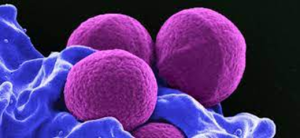MRSA is meticillin (previously known as methicillin) resistant Staphylococcus aureus.
Staphylococcus aureus is a common germ that can live harmlessly on the skin and/or in the nose of about 1 in 3 people. MRSA is a type of Staphylococcus aureus that has become resistant to a number of different antibiotics. However, effective treatment is available.
Most people who are carrying MRSA on their bodies or in their nose don’t suffer any ill effects. However, if someone has MRSA infection, they will be unwell and have symptoms of infection, such as pain, high temperature, soreness/swelling at site of infection.
